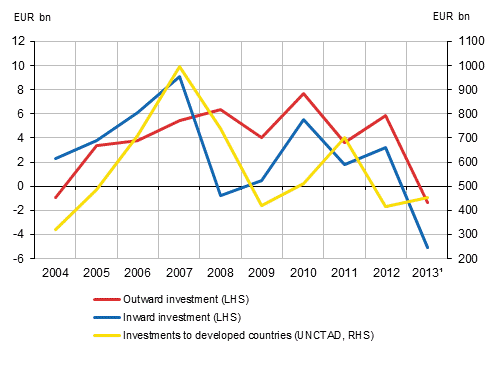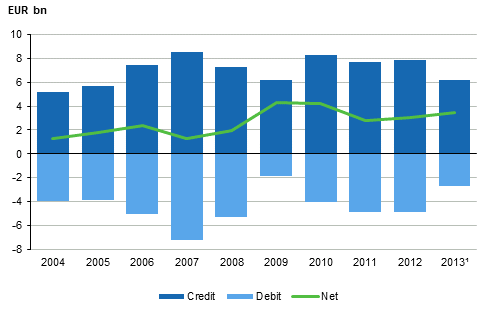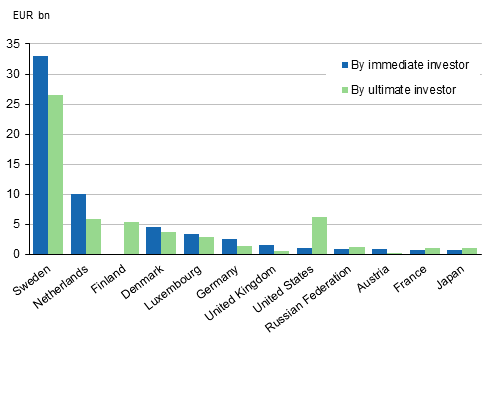1. Foreign direct investments in 2013
This review is divided into two parts. Section 1 examines the figures of direct investments in 2013. Section 2 discusses changes in the statistical standards and their impacts on the published figures. The definitions of the concepts used in this review can be found in the statistics home page: http://www.stat.fi/til/ssij/kas_en.html.
1.1 Direct investments globally
According to the investment report published by the United Nations Conference on Trade and Development, flows of global FDI grew by nine per cent in 2013 from the previous year (UNCTAD: World Investment Report 2014). During the same period, world trade increased by 2.5 per cent and the whole world's GDP by 2.0 per cent. In 2013, direct investments increased particularly due to new investments related to the production of shale gas, corporate acquisitions of international pharmaceutical enterprises and other arrangements, and grown investment assets of private equity funds. The report predicts that investment flows will grow in coming years as well, although increasing economic and political instability in some emerging market areas brings risks to the realisation of the growth forecast.
Figure 1. Flows of FDI in 2004 to 2013

1) The figures for 2013 are not comparable with those for the years 2004 to 2012 due to changes in the international statistical standard. Changes and their effects are discussed in more detail in Section 2 of the review included in this publication.
1.2 Finland's inward FDI
The year 2013 was the second successive year of downturn for Finland's economy. Gross domestic product went down by 1.2 per cent and the unemployment rate rose from 7.7 to 8.2 per cent. The external balance of Finland's national economy also weakened. Exports decreased by 2.6 per cent from the previous year and the current account showed a deficit of EUR 2.9 billion. Finland did not attract as much FDI as in the previous years either. Finland's inward FDI totalled EUR -5.0 billion on net. New inward capital flow was thus clearly lower than outward capital flow. In this case, outward capital flow refers to repatriation of investments abroad or to loans granted by the direct investment enterprise to the direct investor.
At the end of 2013, the value of FDI was EUR 63.2 billion, of which equity accounted for EUR 55.2 billion and the value of debt capital for EUR 8.0 billion. At the end of 2012, the value of FDI amounted to EUR 73.2 billion, of which the share of equity was EUR 57.9 billion and debt capital EUR 15.4 billion. Equity thus decreased by EUR 2.7 billion, which is mostly explained by negative net investment flow. Changes in the statistical practices are in turn the main reason for debt capital being cut in half and thus also the whole investment stock falling clearly from the year before (see Section 2).
Examined by country, direct investments have been made to Finland particularly from Sweden (52% of the investment stock), the Netherlands (16%) and Denmark (7%). Examined by country groupings, investments to Finland mainly come from the EU area, whose combined share of the investment stock was 92 per cent in 2013. The share of eurozone countries was 30 per cent in 2013. These shares were calculated by the immediate investor country. In fact, investments are often managed through an affiliate abroad, in which case the ultimate controlling investor is located in another country. These figures calculated by the ultimate investor are examined in more detail in Section 1.5 of this review.
Examined by industry, inward FDI is particularly directed to financing and insurance activities and service enterprises. The industry of the investment is determined by the industry of the domestic unit with foreign liabilities. Then the share of financing and insurance activities is increased by arrangements where a Finnish manufacturing enterprise, for example, is managed from abroad through a domestic holding company established for that purpose.
Finland's inward FDI generated returns of EUR 2.7 billion in total for foreign investors. Dividends paid for these investments amounted to EUR 4.5 billion and interests to EUR 0.7 billion, that is, in total clearly more than the total return on capital in 2013. The difference was EUR 2.5 billion, which is recorded as a negative item in reinvested earnings and correspondingly, it reduces the inward FDI flow. Reinvested earnings describe the difference between the returns accrued and paid to owners in a given year. Negative reinvested earnings are produced in a situation where the return assets generated in earlier years are distributed to owners in one year.
Returns relative to the value of investments decreased from earlier years. In 2013, returns relative to the value of investments at the end of the year were 4.3 per cent, while in 2010 to 2012, the rate of return was 6.6 per cent, on average.
1.3 Finland's outward FDI
In 2013, outward FDI totalled EUR -2.0 billion on net. Thus, new outward capital flow was clearly lower than inward capital flow. In this case, inward capital flow refers to repatriation of investments or to loans granted by the direct investment enterprise to the direct investor. Most outward capital flow on net was direct investments to Switzerland, Ireland and Belgium. Most capital invested in direct investments was in turn repatriated from the Netherlands, Germany and the United States.
At the end of 2013, the value of outward FDI was EUR 106.9 billion, of which equity accounted for EUR 101.2 billion and the value of debt capital for EUR 5.7 billion. At the end of 2012, the value of outward FDI amounted to EUR 114.7 billion, of which the share of equity was EUR 104.3 billion and debt capital EUR 10.5 billion. Equity thus decreased by EUR 3.1 billion, which is mostly explained by negative net investment flow. Changes in the statistical practices are in turn the main reason for debt capital being cut in half and thus also the whole investment stock falling clearly from the year before (see Section 2).
Examined by country, FDI is especially directed to Sweden (31% of the investment stock) and to the Benelux countries (27%). Examined by country groupings, investments from Finland are mainly directed to the EU area, whose combined share of the investment stock was 81 per cent in 2013. The share of the countries belonging to the currency union was 46 per cent at the end of 2013. Significant direct investments outside the EU are found in the United States (EUR 8.7 billion) and Russia (EUR 2.8 billion).
The shares above were calculated according to the country of the immediate investment target, in which case the appeal of the Asian emerging economies is less apparent than expected. For example, the value of investments to China was EUR 1.3 billion and to India EUR 0.1 billion at the end of 2013, while according to the statistics on Finnish affiliates abroad, Asia's share of the turnover generated abroad was 16 per cent in 2012. There are no data available on outward FDI according to the country of the ultimate investment target, so it is not possible to give a more exact specification of the final investment target. Most of the investments to the Benelux countries are connected to the management of a multinational enterprise or its part and the actual production activity is located in some other country - e.g. in Europe or Asia.
Examined by industry, enterprises having made foreign direct investments mainly represent the metal industry and service industries. At the end of 2013, the value of investments by metal industry enterprises was in total EUR 33.5 billion, of which EUR 7.2 billion was directed to the United States, EUR 6.0 billion to Belgium and EUR 5.0 billion to Sweden. In turn, the value of service enterprises' investments was EUR 33.8 billion at the end of 2013. These investments were centred strongly in Sweden (EUR 19.0 billion) and the Netherlands (EUR 7.7 billion).
Outward FDI generated returns of EUR 6.2 billion in total for Finland in 2013. Dividends from these investments amounted to EUR 5.7 billion and interests to EUR 0.3 billion. Returns gained by Finland relative to the value of FDI also decreased from the year before. In 2013, the rate of return was 5.8 per cent, while in 2010 to 2012 the figure was 7.4 per cent, on average.
1.4 Direct investments in the balance of payments
At the end of 2013, the value of Finland's inward FDI was EUR 63.2 billion and that of outward FDI was EUR 106.9 billion. Finland thus has clearly more assets than liabilities from direct investments. These investments have a significant effect on Finland's net international investment position, in total EUR +43.7 billion. In particular, direct investments improve the net international investment position of the business and financing sectors. Net international position connected to direct investments is the same in the statistics on balance of payments and international investment position, although the gross figures of balance of payments differ from the figures presented here according to the directional principle (The differing statistical method of balance of payments is discussed more in Section 2.2).
In 2013, returns on outward FDI amounted in total to EUR 6.2 billion and on inward FDI to EUR 2.7 billion. This property income is recorded in the primary income item of Finland's current account and its net effect on Finland's current account was EUR +3.4 billion in 2013. From the viewpoint of Finland's current account, returns on direct investments were also the only type of investment in surplus. The net effect of returns from portfolio investment on the current account was EUR -1.7 billion and that of other investments EUR -1.3 billion.
Figure 2 also shows that returns connected to direct investments have improved Finland's current account throughout the reference period 2004 to 2013. Annual returns gained by Finland have varied between EUR 5.2 and 8.5 billion and these investments have yearly produced a surplus of EUR 1.2 to 4.3 billion.
Figure 2. Returns on FDI in 2004 to 2013

1) The figures for 2013 are not comparable with those for 2004 to 2012 due to changes in the international statistical standard. Changes and their effects are discussed in more detail in Section 2 of the review included in this publication.
1.5 Investments according to the ultimate investing country
The new statistical standards and data collected on a more detailed level than before enable country-specific analyses of direct investments by the ultimate investing country. FDI statistics have traditionally been compiled only on the basis of the immediate investor country. The ultimate direct investor here refers to the one that is topmost in the ownership chain of the foreign direct investor. The ultimate direct investor is not controlled by any other unit and it can also be a domestic unit.
Figure 3 shows that direct investments to Finland have been made clearly more from Sweden and the Netherlands if investments are viewed according to the immediate investor country. This indicates that these investments are made through an enterprise located in Sweden or the Netherlands, although the actual investor is elsewhere. The case is opposite for the United States. The FDI stock to Finland from the United States is larger when viewed on the basis of the ultimate investing country (EUR 6.3 billion) than on the basis of the immediate investor country (EUR 1.0 billion). This means that a larger share of FDI into Finland is managed in the USA than what is made immediately into Finland. Investments from Japan, France and Russia are larger if they are viewed on the basis of the ultimate investing country. In examining by the ultimate direct investor, the share of Finland is also significant. This is caused by domestic enterprises recycling capital through their affiliates abroad back to Finland.
Figure 3. Foreign direct investments to Finland by the investor's home country in 2013, investment stock

Source: Foreign direct investments 2013, Statistics Finland
Inquiries: Kristian Taskinen 029 551 2238, Laura Wallenius 029 551 2997, balanceofpayments@stat.fi
Director in charge: Leena Storg�rds
Updated 18.11.2014
Official Statistics of Finland (OSF):
Foreign direct investments [e-publication].
ISSN=2342-351X. 2013,
1. Foreign direct investments in 2013
. Helsinki: Statistics Finland [referred: 26.4.2025].
Access method: http://stat.fi/til/ssij/2013/ssij_2013_2014-11-18_kat_001_en.html

